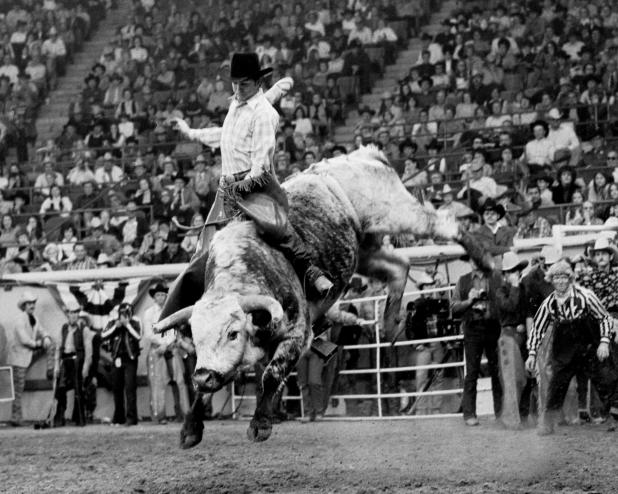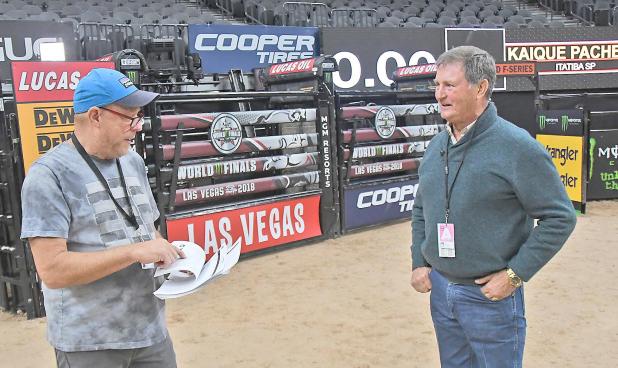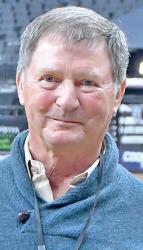
Gustafson Photo
Jerome Robinson riding in the 1973 world finals.

www.johnsonpublications.zenfolio.com Russ Pankonin | Johnson Publications
Jerome Robinson, right, visits with his assistant to make sure everything is in order for the coming night’s performance during the PBR National Finals in Las Vegas in early November. Robinson has served as arena director for the PBR since its inception 25 years ago.
From bucking cows to bulls to producing the PBR

It takes a rare breed of athlete who knowing and willingly jumps on the back of a mean 2,000-lb. bull for an eight-second battle between man and bucking beast to prove whose better.
Professional bull rider Jerome Robinson, who grew up along the railroad tracks in Brandon, rose up to become one of the best bull riders in the world during his legendary riding career.
He built a life-long career in the business going from rider to promoter and producer.
After 10 years of producing his own bull ridings and rodeos around the world, Robinson began producing bull ridings for the PBR (Professional Bull Riders association).
Twenty five years later, the PBR still looks to Robinson to produce their shows across the country.
In early November, Robinson joined the PBR in celebrating their 25th National Finals, which is now held annually in Las Vegas.
* * * * * * * * * * *
Growing up, there was no high school rodeo circuit like today for Robinson to hone his skills.
“We’re talking three rodeos a year. I remember I went to Harrison a couple times and Ogallala had a high school show. Thedford had one,” he said during an interview prior to one of this year’s PBR Finals performances.
That meant he had to look for other ways to get experience.
“I’ve been on a lot of cows. We used to buck cows but we weren’t supposed to,” he recalled.
Robinson built a chute on their place at Brandon. So on Sundays, while his parents were still enjoying social time after church, he’d leave right away, go home, change clothes and have the cows bucked before his dad and mom ever got home.
“What I’d do is when the cattle came into the water that morning, I’d lock them up in an old hog shed where dad couldn’t see ’em.
“When I got home, I’d run the cows in, flank ’em and buck them myself. So by the time they got home from church, I’d already had three or four bucked and they were already back out in the pasture,” he recalled with a big grin.
He said his dad, Grady, who built his own reputation as an auctioneer, didn’t like him riding the cows, especially the dry ones that he was going to sell.
But Robinson said they bucked much better than the cows that had calves on them.
It was on one of those dry cows that Robinson said he made his best cow ride ever, but there was no one there to verify it.
“About that time, I see Ronnie Stewart, that lumberyard that he owned was right there. He was out back and Ronnie was the only guy that ever saw my best cow ride ever,” he recalled.
* * * * * * * * * * *
After retiring from bull riding in 1982, Robinson attended a production school. From there, he put what he’d learned into action.
In 1983, he helped run a prototype tour, called the Winston Tour, which was televised. It featured the top riders and the top stock, week after week, over its two-year span.
Everything the PBR has turned into was conceptualized by that tour, he said. The guy that started it almost wrote the playbook for the PBR, he added.
In 1987, Robinson bought out the rodeo production company he was working with and began promoting and running his own shows.
He even ventured overseas and put on rodeos in France, Finland and Japan.
He would ship bucking horses over from the states but would use bulls from those other countries.
He said it was easier, regulation-wise, to ship horses compared to cattle. As a result, the bulls generally weren’t that good, he noted.
In Japan, they didn’t get excited about the rough stock riding. Instead, they especially liked the clowns, drill team riding, whip-cracking demonstrations and the calf roping.
They thought the calf roping was a comedy act as the cowboys struggled to get the calf on the ground and tie them up.
Over the years, he’s bought and sold several production companies but still holds on to one of them.
He also started his own bull riding school at the place he still calls home—Fort Collins, Colorado.
He helped teach some of the best bull riders on the PBR circuit and helped the college bull riding team lead the nation for several years.
* * * * * * * * * * *
Robinson’s real career in bull riding began as a sophomore at Colorado State College in Fort Collins, where he had visions of becoming a veterinarian.
He joined the rodeo club and his passion for riding bulls began to grow. By the time he finished college, he knew he wanted to chase his dream of riding bulls for a living.
He got his first Professional Rodeo Cowboys Association (PRCA) card in 1967 while still in college. After graduation, he set his career in motion.
Robinson said he liked to line up 10 days in a row—starting at one rodeo on a Friday and finishing up on Sunday a week later.
Pay out in those days compares nowhere to the millions professionals can make riding today.
It meant driving from rodeo to rodeo, paying entry fees in hopes of winning it back and more.
He remembers paying 18 cents for a gallon of ethyl gas when he started on tour. When it got to 35 cents, he said they all thought that was outrageous.
Motel rooms, if they got one, were shared by the other guys he was traveling with.
He made his first PRCA national finals in 1970, finishing seventh with earnings of $14,477.
He recalls his hotel room—a room he had all to himself—was $13 a night.
His best finishes in the national finals, which were then held in Oklahoma City, came in 1975 and 1976 when he won fourth both years.
During his career, he put together a stretch where he qualified for the finals 11 of 12 years.
In 1982, Robinson was leading early in the season.
He remembers he was riding really good—until the day he was in a car accident.
He and another friend were driving from Scottsdale, Arizona to Fort Worth, Texas when they hit a patch of ice in West Texas.
He was injured and lost a tooth, but more importantly, doctors had to amputate the tips of his index and middle fingers on his right hand.
Robinson remembers the accident occurred on a Friday—the day he was supposed to be up at Fort Worth. They told him they would hold his bull till Sunday if he could still make it.
That night, he said he couldn’t even raise his head up to get out of the bed.
“I figured I was done for because I had to reach behind my head to pick my head up off the pillow,” he said. “If you told me I was going to be able to ride Sunday....”
By Saturday, he said he was much better and was walking all around the hospital.
He had a friend whose dad had a Cadillac dealership in the town where the accident happened, and needed to deliver one to Fort Worth.
The friend picked him up from the hospital Sunday morning and he rode his bull that afternoon.
Because Robinson rode with his left hand on the rope, he could get on without hurting the fingers on his right hand.
He made his eight-second ride and qualified for the finals that night, where he made his second eight-second ride of the day to finish in the money.
When he got off bull, he remembers landing kind of funny. When he went to get up, he couldn’t. He figured his knee had popped out.
When they got him back to the first aid station (there were no sport medicine doctors on hand, like today,) his knee popped back in.
However, he later learned a ligament pulled loose from the bone. That meant surgery and in those days, he was in a cast for six weeks.
Fortunately, he said that was about the worst injury he ever suffered during his career.
He was able to come back later that season, but he said he never rode as good as he was riding before the accident and didn’t make the finals. At the age of 35, it was time to retire.
* * * * * * * * * * *
When the PBR first began, it was Robinson’s production company that provided all the chutes and panels and did all the setup for each show.
That included everything from hanging lights, to hiring security, to leasing saddle horses and bringing in dirt for the arena.
Interestingly enough, they bring in about eight inches of dirt to cover the arena floor. Most of the time, that comes after there has been a basketball or hockey game on the arena’s floor or ice.
Today, Robinson has a steady crew of 10-15 who put everything together and take it down.
Since 1989, he’s used the same Ohio company to bring in and prepare the dirt and remove it after the show. The company also brings in dirt for indoor motor sport events.
Robinson loves what he does, serving as “arena director” for the PBR for the last 25 years.
It has kept him close to the sport he loves so much. Even today, when a bull comes out of the chute, he visualizes in his mind what moves he’d make to ride that particular bull.
Running the PBR productions also means a significant travel schedule. He said he’s usually home two to three days early in the week.
He credits his wife, Dorya, for keeping things together at home during his career and for playing a big role in raising their grown daughter, Amy.
A 1965 graduate of Venango, Robinson said he doesn’t get back to Grant and Perkins County much since his dad passed away in 2014, but his ties to the area, and the friends he made growing up, still remain key for him.
Need proof? After all these years, he still banks in Grant, dating back to when the Jackmans and Don Sexson owned what is now Pinnacle Bank, making his first deposit at the age of 6.
